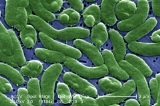
Vibrio vulnificus
Overview
Gram-negative
Gram-negative bacteria are bacteria that do not retain crystal violet dye in the Gram staining protocol. In a Gram stain test, a counterstain is added after the crystal violet, coloring all Gram-negative bacteria with a red or pink color...
, motile, curved, rod-shaped bacteria of the Vibrio
Vibrio
Vibrio is a genus of Gram-negative bacteria possessing a curved rod shape, several species of which can cause foodborne infection, usually associated with eating undercooked seafood. Typically found in saltwater, Vibrio are facultative anaerobes that test positive for oxidase and do not form...
Genus
Genus
In biology, a genus is a low-level taxonomic rank used in the biological classification of living and fossil organisms, which is an example of definition by genus and differentia...
. It was first reported (as the "Lactose-positive vibrio") by Hollis et al. (J. Clin. Microbiol.
Journal of Clinical Microbiology
The Journal of Clinical Microbiology is a medical journal published by the American Society for Microbiology....
) in 1976. It was subsequently given the name Beneckea vulnifica by Reichelt et al. in 1976 (Archives Microbiology), and finally Vibrio vulnificus by Farmer in 1979 (Lancet
The Lancet
The Lancet is a weekly peer-reviewed general medical journal. It is one of the world's best known, oldest, and most respected general medical journals...
). Present in marine environments such as estuaries
Estuary
An estuary is a partly enclosed coastal body of water with one or more rivers or streams flowing into it, and with a free connection to the open sea....
, brackish ponds, or coastal areas, V.
Unanswered Questions

